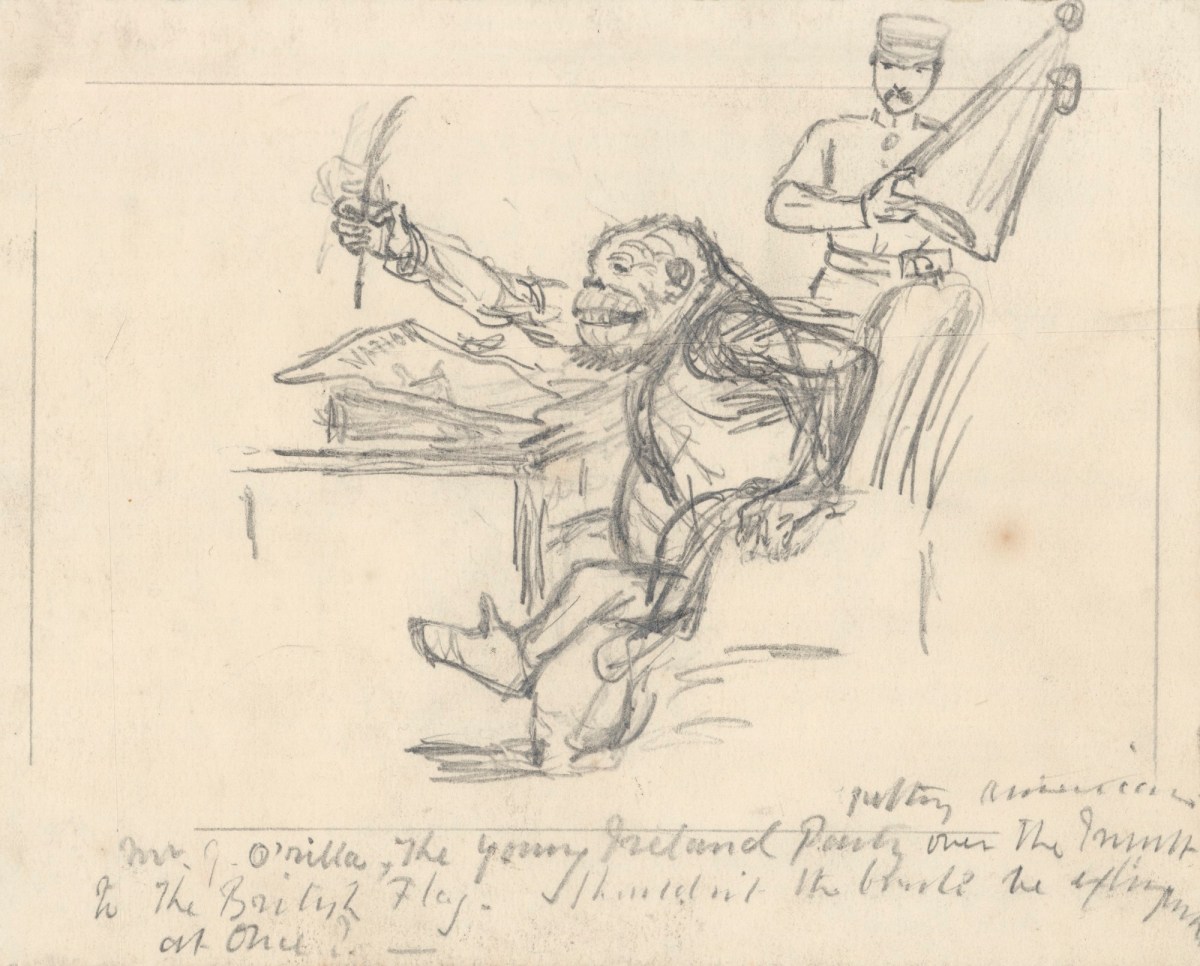
John Leech, Sketches for cartoons in Punch Magazine including 'A Good Day for Ireland', 1860s.
Pencil on wove paper. 149 mm x 188 mm. © Photo: Royal Academy of Arts, London.
This image is not available to download. To licence this image for commercial purposes, contact our Picture Library at picturelibrary@royalacademy.org.uk
Sketches for cartoons in Punch Magazine including 'A Good Day for Ireland', 1860s
John Leech (1817 - 1864)
RA Collection: Art
This object contains visual material that may be upsetting or offensive. Where possible, we are in the process of providing additional information about the object to contextualise its content, production and meaning in the society and era in which it was created. We continuously work to improve the documentation and presentation of our online Collections. If you have any comments or additional information about the object/object record, please contact us at library@royalacademy.org.uk.
The drawing on the recto of this sheet is a sketch for one of John Leech's cartoons for Punch magazine satirising Irish nationalists. A version of the cartoon was published under the title 'A Great Time for Ireland' in 1861. At this date the magazine was very supportive of the British establishment and took a particularly hard line against calls for Irish independence. This was reflected in the frequent publication of derogatory images of the Irish, both in written descriptions and cartoons.
In many of his Punch cartoons, John Leech employed racist and negative national stereotypes. This example portrays Irish nationalists as monkeys in tail coats. Leech frequently identified such figures as members of the 'Young Ireland' party, as here, referring to a nationalist group founded in 1842. This cartoon shows a 'Mr G.O'Rilla' seated at a desk reading a paper. The published version was accompanied by an extract from an article from the Irish paper The Nation (founded by members of 'Young Ireland'), discussing the possibility that Britain would become embroiled in the American Civil War. The author expressed the hope that 'England' would be defeated as punishment for its ill-treatment of the Irish and that this would in turn lead to the establishment of an independent Ireland. Leech's response was to show Mr G. O'Rilla "exulting in the insult to the British Flag" and to call for "the brute" to be "extinguished at once". In the published version the wording was changed to read 'Shouldn't he be extinguished at once?'.
On the verso of the sheet is another sketch for one of Leech's Punch cartoons, published in 1862 (Punch 42, VIII). This scene was entitled 'Jones has an Equestrian Portrait for his Carte de Visite'. It is one of a number of cartoons by Leech on the theme of the contemporary vogue for photographic 'cartes' making fun of the sitters' pretensions. In this case, the man on horseback on the left refuses to dismount from his horse, therefore having an 'equestrian portrait' taken for his carte. The photographer prepares to take the shot while a group of children gather to watch.
Further reading:
Roy Douglas, Liam Harte and Jim O'Hara, Drawing Conclusions: a Cartoon History of Anglo-Irish Relations, 1798-1998 , 1998
M. H. Spielmann, The History of "Punch" , London 1895
Most of the drawings in this group have been identified as John Leech's sketches for Punch magazine cartoons, carried out between the late 1840s and the early 1860s. The rest of the sketches are also likely to relate to Leech's work for Punch but it is possible that some were for other publications to which he contributed such as Once a Week and the Illustrated London News.
Many of the drawings relate to current affairs. Punch magazine, at this time, was very much supportive of the British establishment and Leech's characterisation of certain groups, both in political and more light-hearted images, played on and re-inforced negative racial stereotypes. These drawings, for instance, include such imagery relating to the Indian Rebellion of 1857, Irish nationalism and Jewish MPs.
Some of Leech's less politically-charged subjects are also represented here. Several cartoons satirise polite society while there are also sketches making fun of contemporary male and female fashions. One drawing depicts organ grinders and relates to the artist's intolerance of urban noise.
Leech was born in London and studied medicine at St Bartholemew's hospital but after his father was declared bankrupt in 1830 he began to sell sketches and cartoons for extra income. As a medic, Leech studied anatomical drawing but he had no formal training as an artist and his drawings are typified by a lively, almost frenetic, style. Leech built up a successful career as a cartoonist and illustrator and remains best known for the work he produced for Punch magazine. He was a friend of many artists and writers of the day including John Everett Millais, William Thackeray and Charles Dickens.
Object details
149 mm x 188 mm



